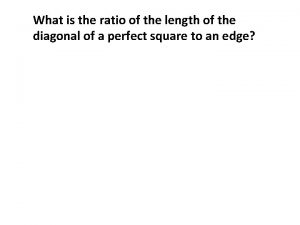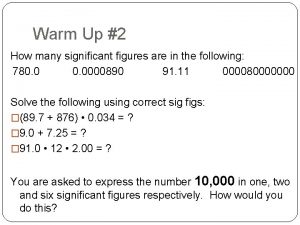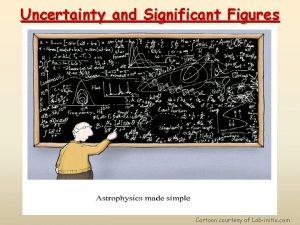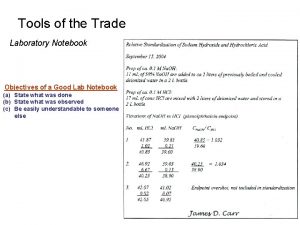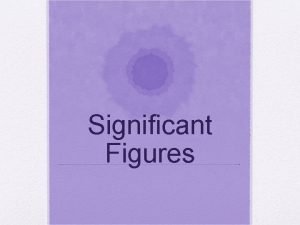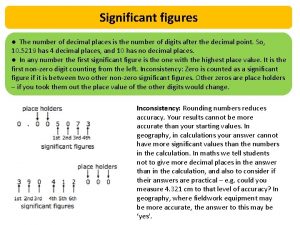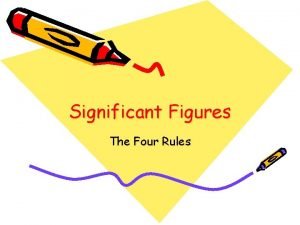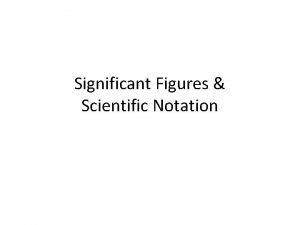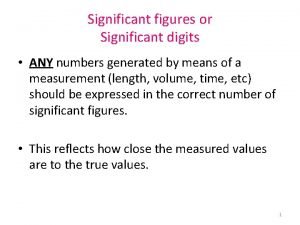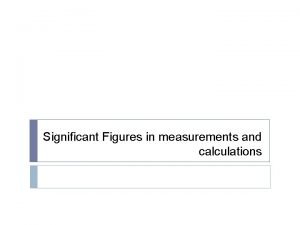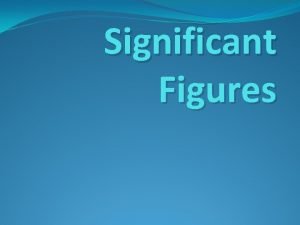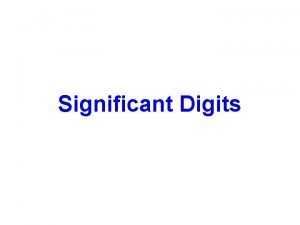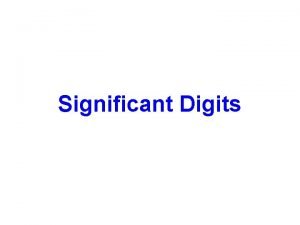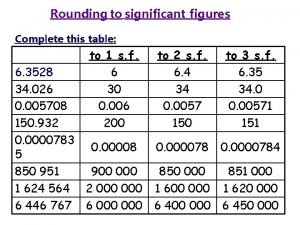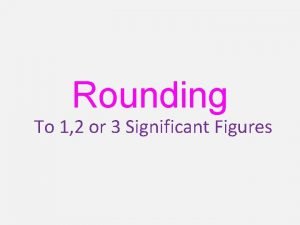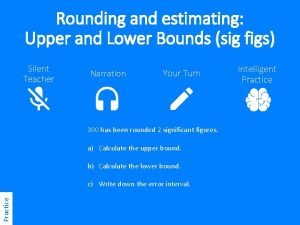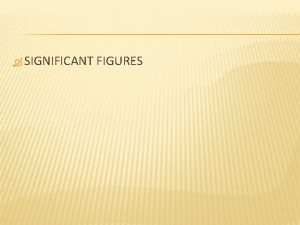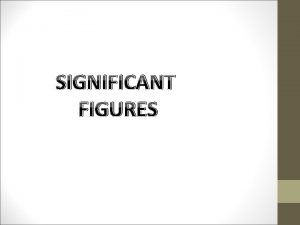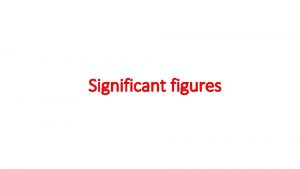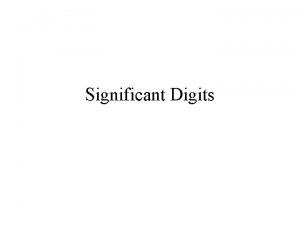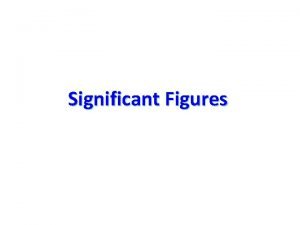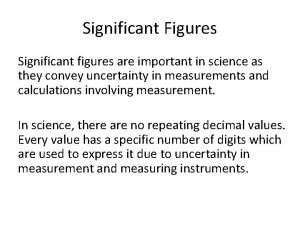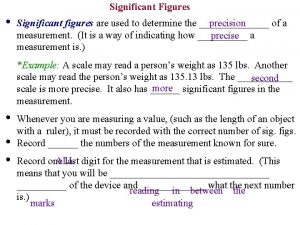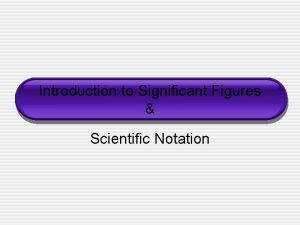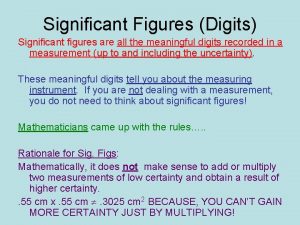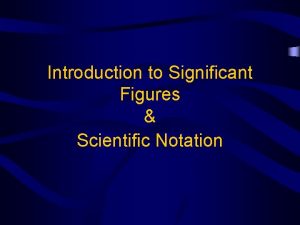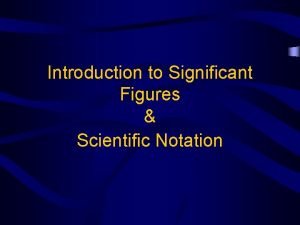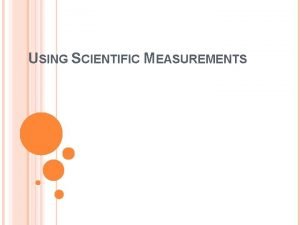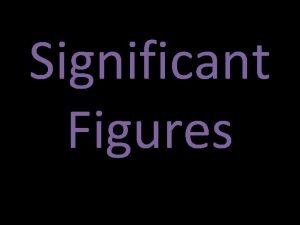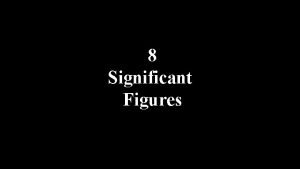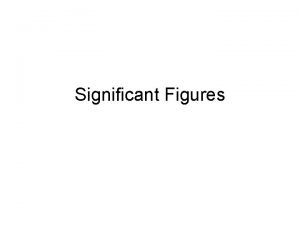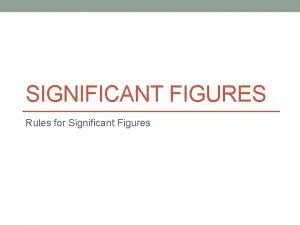Significant Figures Measure the length of your hand
























- Slides: 24

Significant Figures • Measure the length of your hand in cm. • Use the hand measurement to find the width of the counter. Write down the width: ____ cm • Take off a shoe. Measure its length in cm. • Use the shoe measurement to find the width of the counter. Write down the width. ____ cm • Measure the width with the meterstick. • Write down the width. ____ cm

Significant Figures • All IB calculations must report answer to correct # of sig fig’s. • All lab measurements must be reported to correct sig fig’s and correct sig fig’s with uncertainties must be reported properly.

There are 2 kinds of numbers: – Exact: the amount of money in your pocket. Known with certainty. Approximate: weight, height— anything MEASURED. No measurement is perfect. No fractions

When to use Significant figures • When a measurement is recorded only those digits that are dependable are written down.

What is this measurement? 1. 36 cm That is the precision of the instrument.

Reporting Sig Fig’s in measurement Analog Instruments • Report to the smallest or half the smallest measure on instrument. That will be the best you can read. There will be situations where the measure will be much less precise than that. • Rulers, protractors, analog scales

The smallest measure is 0. 1 cm so report to within 0. 1 or 0. 05 cm. The last digit is an estimate.

Digital Instruments • Use the place of the last digit at best. 1. 00 V

• Review the rules of Sig Figs

How do I know how many Sig Figs are in a reported number? • All digits in the prefix before a power of 10 are significant. • 2. 2 x 102 • 1. 34 x 10 -2 • 4. 0012 x 109.

How do I know how many Sig Figs not in sci notation? • All non-zero digits are signicant. • All digits are significant starting with the first non-zero digit on the left. • 0. 0022 has 2 sig fig’s

• Exception to rule: In whole numbers that end in zero, the zeros at the end are not significant. 100 Has 1 sig fig.

How many sig figs? • 7 • 40 • 0. 5 • 0. 00003 5 • 7 x 10 • 7, 000 • 1 • 1 • 1

• nd 2 Exception to rule: If zeros are sandwiched between nonzero digits, the zeros become significant. 1001

• 3 rd Exception to rule: If zeros are at the end of a number that has a decimal, the zeros are significant. They are there to show precision. 3. 000

• 3 rd Exception to rule: • These zeros are there to show precision in the measurement or calculation.

How many sig figs here? • • • 1. 2 2100 56. 76 4. 00 0. 0792 7, 083, 000 • • • 2 2 4 3 3 4

How many sig figs here? • • • 3401 2100. 0 5. 00 0. 00412 8, 000, 050, 000 • • • 4 2 5 3 3 6

Rounding Rules • If digit just past last sig fig is 5 or more round up. If we need two sig fig’s, • 3. 67 3. 7 5. 55 5. 6 • If digit past last sig fig is 4 or less drop off last numbers: 3. 322 3. 3

What about calculations with sig figs? • Rule: When adding or subtracting measured numbers, the answer can have no more places after the decimal than the LEAST of the measured numbers.

Add/Subtract examples • 2. 45 cm + 1. 2 cm = 3. 65 cm, • Round off to = 3. 7 cm • 7. 432 cm + 2 cm = 9. 432 round to 9 cm

Multiplication and Division • Rule: When multiplying or dividing, the result can have no more significant figures than the least reliable measurement.

A couple of examples • 56. 78 cm x 2. 45 cm = 139. 111 • Round to 139 cm 2 • 75. 8 cm x 9. 6 cm = ? 730 cm 2. 2 cm

• Hwk Kerr pg 9 #2 – 12.
 What is the ratio of the length of to the length of ?
What is the ratio of the length of to the length of ? Significant figures ap chemistry
Significant figures ap chemistry Rules for significant figures
Rules for significant figures Uncertain digit calculator
Uncertain digit calculator Significant figures cartoon
Significant figures cartoon Logarithm significant figures
Logarithm significant figures Significant figures ap chemistry
Significant figures ap chemistry What does significant figures mean in math
What does significant figures mean in math Significant figures kuralları
Significant figures kuralları Significant figures table
Significant figures table Rules for sig figs
Rules for sig figs What are significant digits in math
What are significant digits in math Significant figures in measurements
Significant figures in measurements How many sig figs when reading a thermometer
How many sig figs when reading a thermometer Significant figures chemistry
Significant figures chemistry How many significant figures
How many significant figures 3 significant figures examples with answers
3 significant figures examples with answers Three significant digits
Three significant digits How many significant figures does 9876 have
How many significant figures does 9876 have Purpose of significant figures
Purpose of significant figures Significant figures meaning
Significant figures meaning Round 34 to 3 s.f
Round 34 to 3 s.f Round to 1 sf 564
Round to 1 sf 564 How to find upper and lower bounds of significant figures
How to find upper and lower bounds of significant figures Nernst equation simplified
Nernst equation simplified
